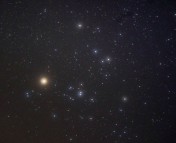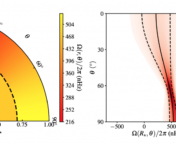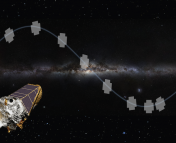Title: Flares in Open Clusters with K2. II. Pleiades, Hyades, Praesepe, Ruprecht 147 and M67
Authors: Ekaterina Ilin, Sarah J. Schmidt, Katja Poppenhäger, James R. A. Davenport, Martti H. Kristiansen, Mark Omohundro
First Author’s Institution: Leibniz-Institute for Astrophysics Potsdam (AIP), An der Sternwarte 16, 14482 Potsdam, GermanyStatus: Accepted in Astronomy & Astrophysics
Stellar flares are massive explosions of light and plasma that occur on virtually all main sequence stars that host a convection zone. You may have heard of solar flares happening on the Sun, causing ejection of particles towards Earth and causing particularly bright aurorae. On flaring stars, including the Sun, flares are associated with stellar magnetic activity. When a star is showing high magnetic activity, there are a lot of flares, and vice versa. We can see this across the 11 year cycle of the Sun, for example.
The stellar activity of a star — related to the amount of star spots and flares visible on the surface — can change dramatically over a star’s lifetime. Young or low-mass stars will flare brightly and frequently, whereas older or more massive stars flare infrequently. The rotation of a star also plays a role here, as a faster rotation is believed to be related to more star spots and higher levels of magnetic activity. As stars age and lose angular momentum their rotation will slow down, thus also reducing their magnetic activity.
Today’s authors take a big leap in the direction of understanding stellar flares. In a previous study, they showed that flaring activity declined with age. In today’s paper, they verify this with a much larger sample of stellar flares, and see how these trends unfold in different stellar types.
Stellar Laboratories
In order to study how flaring activity changes with age, today’s authors wanted to make sure they had a sample of stars for which the age was well constrained. For this they used open clusters— groups of stars that all formed together, and so have the same age. The age of clusters can be relatively reliably determined, and so provide perfect ‘laboratory conditions’ for testing age-based hypotheses.
Using data from the space-based K2 mission, the authors set out to measure stellar flares in 5 clusters: the Pleiades (~100 million years (Myr) old), Hyades (~650 Myr), Praesepe (~700 Myr), Ruprecht 147 (~2.5 billion years (Gyr)) and M67 (~4 Gyr). Using their flare finding algorithm — dubbed AltaiPony (named after the breed of horse) — they were able to identify 3844 flares in a total of 2111 stars across the five clusters, with the most being in Praesepe, and only a couple in the older systems of Ruprecht 147 and M67.
Figure 1: The flare frequency distributions (controlled for stellar luminosity) versus cluster age. Stars have been grouped into bins of different temperature (as a proxy for mass), and the points show the average value for stars in that bin. Globally, the frequency of flares reduces with age, and declines faster in the hotter stars (at the bottom of the figure). In a bit more detail: the metric for flare frequency shown on the y-axis is the intercept of a power law fit to flare frequency against the area under a flare in the time series of a star (called equivalent duration, or ED). ED is independent of stellar luminosity, and so useful when comparing different stellar types in this study. These power law fits are shown as black lines in Figure 2 below. Figure 6 in the paper.
The results from these 2111 stars indicated that the conclusion of their previous paper was correct — flaring activity declines with age. Using stellar temperature as a proxy for mass (more massive stars are hotter on the main sequence) they show that this decline in activity is more rapid for more massive stars (see Figure 1). The flaring rates they found were also consistent with previous ground- and space-based studies, providing credibility to their results.
Two clusters, both alike in metallicity
Amongst the five clusters the authors measured flares for, Hyades and Praesepe are most similar. Both have ages around ~650-700 Myr, and have very similar metallicities (the fraction of the star that isn’t helium or hydrogen), which may affect the evolution of activity. So given what we know about flares and age, we would expect the flaring rates of both clusters to be extremely similar. The authors were then surprised to find that for stars of temperatures 3500-3750 Kelvin, this didn’t hold true. In this temperature bin, the Hyades more closely resembled the much younger Pleiades cluster and demonstrated a high flaring frequency.Praesepe, on the other hand, flared much less. The flaring frequency in both lower and higher temperature (mass) stars were consistent, however.
Figure 2: Flare frequency plotted against a the equivalent duration (ED), a metric of the flare energy. Shown for stars in the Pleiades, Hyades and Prasepe clusters. Hyades and Praesepe, which are alike in age and metallicity, are expected to look similar. Panel (d.) in the top right shows a departure from this trend, which is not the case in the lower mass (top left) and higher mass (top right) bins. The lower left bin contained no stars in Hyades. The intercept of the power law fits shown here are the y-axis units in Figure 1. Adapted from Figure 4 in the paper.
This discrepancy could be explained by rotation. The Praesepe stars in this regime all had rotation periods of greater than 10 days, whereas the Hyades and Pleiades stars’ rotation rates were more evenly distributed from short to long periods. Since Praesepe is ever so slightly (~50 Myr) older than the Hyades, today’s authors propose that its slightly older, more slowly rotating stars have transitioned into a less active period of their main sequence lifetimes– a transition that previous studies have shown may lie around periods of 10 days. These Praesepe stars, in the temperature range 3500-3750, will have undergone this transition at some point inbetween the ages of Hyades and Praesepe, so anywhere within ~650 Myr and ~700 Myrs old. Higher mass, hotter stars — who lose angular momentum quickly — will have already undergone this transition in both clusters, and lower mass cooler stars are still waiting to undergo it, causing this discrepancy between clusters to only show up for one class of star. In short, the flare activity at a given age is likely to depend on the stellar mass.
Conclusions
Understanding stellar flares helps us understand the evolution of stars like our Sun, as well as the conditions on exoplanets around low-mass flaring stars (such as the TRAPPIST-1 system). With their large-scale study of flares, today’s authors have quantified how flare frequency changes with age, and indicated that the frequency of flares in stars of the same age depends on their mass. Although the K2 mission has ended, the TESS mission is providing an ever-increasing wealth of light curves in which to find flares, and to further test our understanding of stellar activity.
Featured image credit: NASA/SDO
Edited by: Michael Foley
This article was updated following feedback by the paper authors.




